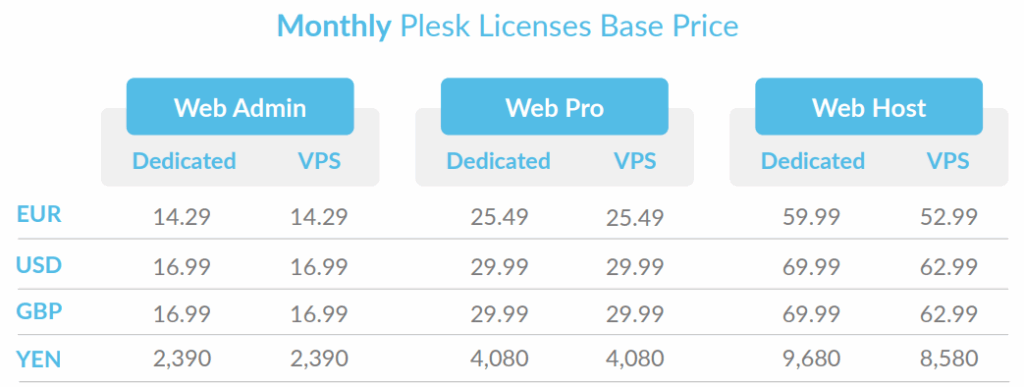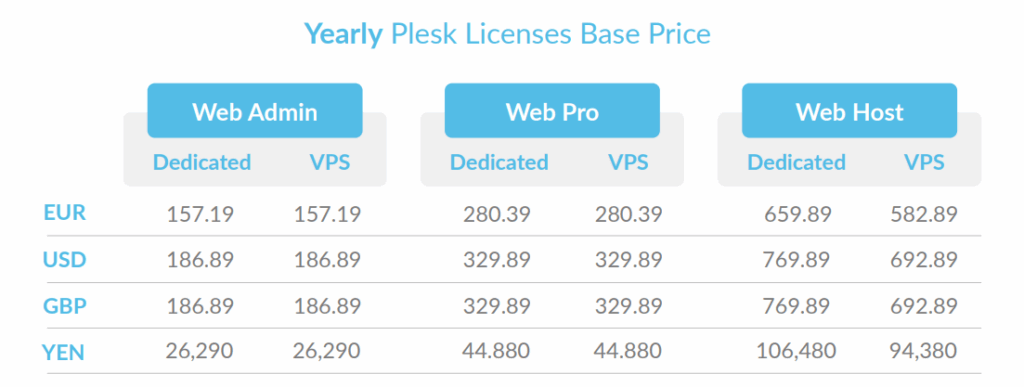January 1, 2026. According to industry sources and partner communications, this update will introduce an average price increase of approximately 26%, alongside a structural change in how subscriptions are billed. These updates follow Plesk’s established pattern of annual price adjustments and reflect broader changes within the WebPros group’s commercial strategy.
Scope of the 2026 price adjustment
Based on current market information, the new pricing will apply across all editions of Plesk licenses — Web Admin, Web Pro, and Web Host — for both VPS and dedicated server environments.
While exact 2026 figures have not yet been officially published on the Plesk website (only via e-mail and Licensing Guide), comparisons with current public pricing suggest that the increase will affect both monthly renewals and existing annual plans, which are being phased out.
For reference, current (2025) monthly retail prices for the main editions are as follows:
| Edition | VPS | Dedicated |
|---|---|---|
| Web Admin | $15,49 | $15,49 |
| Web Pro | $26,99 | $26,99 |
| Web Host | $49,99 | $66,99 |
New Plesk License Pricing


Possible scenario for large-volume Plesk license customers
| Product Type | License | Base Price | Tier 1 | Tier 2 | Tier 3 |
|---|---|---|---|---|---|
| Plesk Core Dedicated | Web Host Edition Monthly | $59.99 | $50.99 | $41.99 | $32.99 |
| Plesk Core Dedicated | Web Pro Edition Monthly | $25.49 | $21.67 | $17.84 | $14.02 |
| Plesk Core Dedicated | Web Admin Edition Monthly | $14.29 | $12.15 | $10.00 | $7.86 |
| Plesk Core VPS | Web Host Edition Monthly | $52.99 | $45.04 | $37.09 | $29.15 |
| Plesk Core VPS | Web Pro Edition Monthly | $25.49 | $21.67 | $17.84 | $14.02 |
| Plesk Core VPS | Web Admin Edition Monthly | $14.29 | $12.15 | $10.00 | $7.86 |
These prices are expected to rise by roughly one quarter starting January 2026, aligning Plesk with similar adjustments implemented by its sister product, cPanel, earlier in 2026.
Market Context and Industry Reactions
The upcoming change is consistent with WebPros’ broader business model under its parent company, Oakley Capital, a private equity firm specializing in recurring-revenue software assets.
Since Oakley Capital’s acquisition of WebPros, both Plesk and cPanel have followed a similar pricing trajectory, with steady year-on-year increases aimed at aligning product value with ongoing development and support investments.
While many hosting providers acknowledge the need for continued platform innovation, the magnitude and frequency of these adjustments have prompted growing attention within the industry. Competitors such as DirectAdmin and Enhance have reported higher migration interest from customers seeking more predictable long-term licensing costs.
Nevertheless, Plesk remains one of the most feature-complete control panels available, with continued investment in WordPress management, security tools, and integrated site-building utilities, which are key differentiators in the professional hosting segment.
Financial impact and planning recommendations
Given the scale of the 2026 increase, hosting providers, agencies, and enterprise users are encouraged to review their operational budgets for Q1 2026 and adjust cost projections accordingly.
For partners managing large numbers of licenses, modeling a 26% increase across all license tiers can provide a reliable baseline for forecasting. Additionally, since the transition to monthly billing will eliminate the possibility of annual rate locking, stakeholders should anticipate ongoing, smaller adjustments on an annual basis.
Plesk’s “Solution” for small hosting businesses facing priceincreases
With the January 2026 price update, Plesk has also started communicating what it considers a “solution” for small hosting businesses struggling with rising costs. The company’s message is clear: there are still ways to remain profitable — if you adapt.
According to Plesk, smaller resellers and hosting providers can manage these upcoming price changes through a mix of strategic cost adjustments and creative revenue models. Suggested measures include:
- Passing part of the cost increase to end users by slightly raising hosting plan prices.
- Introducing usage-based rules (for example, limiting resources or domains per plan) to reduce overhead.
- Offering value-added services — such as security add-ons, website care packages, or WordPress management — to create new income streams.
From a business standpoint, these are reasonable strategies. After all, hosting margins have always depended on balancing costs and perceived value.
Still, it’s difficult to ignore what this really means in practice. For most small hosting companies, these “solutions” translate to shifting costs directly to end customers — the small business owners, freelancers, and bloggers who rely on affordable hosting.
And, understandably, they won’t be happy about it. Price-sensitive clients tend to notice even small increases, especially when hosting is seen as a commodity. Explaining a 20–30% jump in cost — even when justified — can easily trigger frustration or churn.
The problem isn’t that Plesk is offering bad advice. It’s that the advice assumes there’s enough elasticity in the customer base to absorb the change. In reality, many small hosting providers are competing in a race to the bottom, where even a $1 difference can decide whether a client stays or leaves.
So..
Plesk’s 2026 pricing update continues its structured, annual review cycle and reinforces the industry-wide shift toward shorter billing periods and subscription-based pricing. Early financial planning will help users manage the transition smoothly and maintain service continuity.

